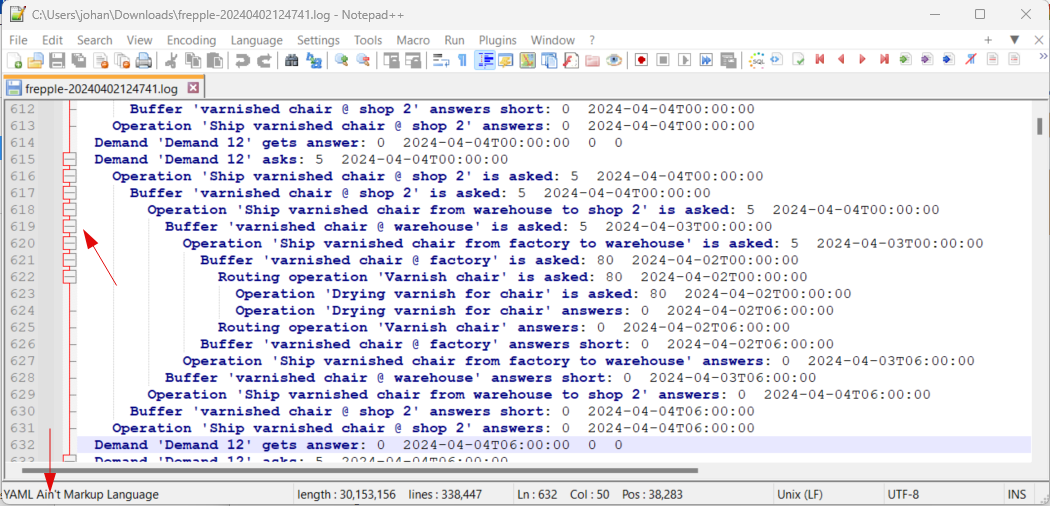Planning algorithm
Different solver algorithms can be used with frePPle.
FrePPLe comes with a default solver, which implements a heuristic search algorithm. The Enterprise Edition provides a second solver, tailored for distribution-oriented supply chains.
The algorithm solves demand per demand. All demands are first sorted based on a) their priority (lower values first) and b) their due date (earlier due dates first). When planning a single demand, the algorithm basically consists of a set of recursive functions structured in a ask-reply pattern, as illustrated in the example below. The indention is such that the ask and its matching reply are represented at the same level.
The ask in each of the above steps consists of 1) ask-quantity and 2) ask-date. The reply used in each of the above steps consists of 1) reply-quantity and 2) reply-date. The reply-quantity represents how much of the requested quantity can be made available at the requested date. The reply-date is useful when the ask can not -or only partially- be met: it then indicates the earliest date when the missing quantity might be feasible.
Pseudo-code of the algorithm
Every demand has a certain delivery operation associated with it, either directly or indirectly by specifying a delivery operation for the requested item.The demand asks this operation for the requested quantity on the due date of the demand.(*) The operation first checks for the lead time constraints.
The operation will ask each of the loads to verify the capacity availability.
A load passes on the question and asks the resource.
The resource replies whether the capacity is available or not.
The load replies the result back to operation.
The operation will ask each of the flows to check the availability of consumed materials.
A flow passes on the question too and asks the buffer.
The buffer checks the inventory situation.If material is available no further recursion is required.If the required material isn’t available the buffer will ask an operation for a new replenishment.Each buffer has a field indicating which operation is to be used to generate replenishments.Depending on the buffer inventory profile, safety stock requirements, etc… the operation may be asked for different quantities and on different dates than the original demand.When an operation is asked to generate a replenishment it evaluates the lead time, material and capacity constraints. This results in a recursive ask-sequence similar as the one starting with the line marked with (*)
…
The maximum recursion depth will be the same as the number of levels in the bill-of-material of the end item.In some cases the iteration can be stopped at an intermediate level.Eg. When sufficient inventory is found in a buffer and no replenishment needs to be asked: a positive reply can be returned immediately.Eg. When an operation would need to be planned in the past (ie lead time constraint violated) a negative reply can be returned immediately.The operation collects the replies from all its flows, loads and -indirectly- from all entities nested at the deeper recursion levels. A final reply of the operation is generated.
Based on the reply of the replenishing operation the buffer evaluates whether or not the replenishments are possible, and replies back to the flow. Sometimes a buffer may need to ask multiple times for a replenishment before an answer can be returned.
The flow picks up the buffer reply and replies to the operation.
From the reply of all its loads and flows the operation returns a reply to the demand. The interaction between material, lead time and capacity constraints is pretty complex and an operation may require several ask-reply iterations over its flows and loads before a final answer can be returned.
The answer of the operation indicates how much of the requested demand quantity can be satisfied on the requested date. Depending on the planning result and the demand parameters (such as allow/disallow satisfying the demand late or in multiple deliveries) we can now decide to commit all operation plans created during the whole ask-reply sequence.
If we’re not happy with the reply the operation plans created are undone again and we can go back to the first step and ask for the remaining material or at a later date.
Debugging the algorithm
You can trace the search of the planning algorithm by setting the parameter “plan.loglevel” to 2. This is will generate a (sometimes very big) log file during plan generation.
The easiest way to review such log files is to use the excellent notepad++ editor and choose the YAML language to format the file. The editor displays collapsible sections which significantly facilitate reviewing big and complex log files.

